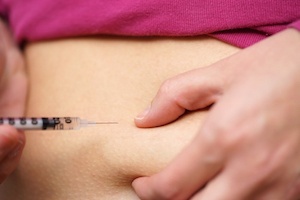
Progesterone is a hormone that is responsible for making the uterine lining receptive (“secretory transformation”) for the embryo to implant. In natural cycles, progesterone is produced after ovulation (“release of the egg from the ovary”) by the corpus luteum (see illustration in my previous blog). In natural cycles, progesterone is produced in sufficient amounts due to continuing signals from the pituitary gland in the brain. In IVF cycles, these signals are often interrupted. This is so because we routinely use medications (Lupron, Ganirelix, Cetrotide) to prevent premature ovulation (prior to harvesting the eggs) in these patients. Also when we do egg retrievals we are puncturing the ovarian follicles with a needle. This may subsequently compromise the ability of the corpus luteum to progesterone. In fact, several studies have shown that is absolutely necessary to give progesterone to IVF patients after the egg retrieval.
There are various routes with which progesterone can be administered including oral, intranasal (nasal spray), sub-lingual (placing a tablet below the tongue), rectal. The commonest routes remain vaginal and intramuscular.
Most patients find it most convenient to take their medications orally. Natural progesterone when taken orally, however, has serious limitations. The main problem is that it gets metabolized by the intestines and then by the liver to weak metabolites. Thus very little progesterone actually reaches the uterus and at least two studies have shown significantly lower IVF pregnancy rates with oral progesterone. Also, oral progesterone makes you drowsy and can cause flushing and nausea. Food intake will interfere with progesterone absorption. For all these reasons, most IVF programs will NOT use oral progesterone. There have been some studies which have looked at the use of "micronized" oral progesterone. This is better absorbed than the regular version but still has some of the other limitations of the oral route.
Many of you will have used an estrogen patch. Estrogen patches are small, discreet and effective. So, why not have one for progesterone? The answer lies in the dose of hormone that is required. Estrogen patches generally deliver “microgram” doses of estrogen. The skin is quite effective in absorbing this dose of estrogen through a small patch. The dose of progesterone is in “milligrams”, which is a thousand times higher. It is therefore impractical to have a “progesterone patch” as to deliver an effective dose it will have to be so large that its use would be impractical (it would be more like a raincoat!).
The nasal spray, sub-lingual tablets and the rectal route have been tested in studies and do work. They, however, have not been widely used clinically. The vaginal and intramuscular route, remain the most widely used and will be discussed in my next blog.
Infertility Infertility treatment IVF Conception InVia Fertility Specialists

Entire Website © 2003 - 2020
Karande and Associates d/b/a InVia
Fertility Specialists
